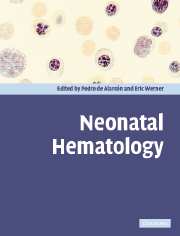Book contents
- Frontmatter
- Contents
- List of contributors
- Foreword
- Preface
- 1 Neonatal hematology: a historical overview
- 2 Disorders of the fetomaternal unit
- 3 Erythropoiesis, red cells, and the approach to anemia
- 4 Anemia of prematurity and indications for erythropoietin therapy
- 5 Hypoplastic anemia
- 6 Hemolytic disease of the fetus and newborn
- 7 Neonatal hemolysis
- 8 Neonatal screening for hemoglobinopathies
- 9 Polycythemia and hyperviscosity in the newborn
- 10 Newborn platelet disorders
- 11 Neutrophil function and disorders of neutrophils in the newborn
- 12 Immunodeficiency diseases of the neonate
- 13 Hemostatic abnormalities
- 14 Transfusion practices
- 15 Umbilical-cord stem-cell transplantation
- 16 Neonatal oncology
- 17 Normal values and laboratory methods
- Index
- References
3 - Erythropoiesis, red cells, and the approach to anemia
Published online by Cambridge University Press: 10 August 2009
- Frontmatter
- Contents
- List of contributors
- Foreword
- Preface
- 1 Neonatal hematology: a historical overview
- 2 Disorders of the fetomaternal unit
- 3 Erythropoiesis, red cells, and the approach to anemia
- 4 Anemia of prematurity and indications for erythropoietin therapy
- 5 Hypoplastic anemia
- 6 Hemolytic disease of the fetus and newborn
- 7 Neonatal hemolysis
- 8 Neonatal screening for hemoglobinopathies
- 9 Polycythemia and hyperviscosity in the newborn
- 10 Newborn platelet disorders
- 11 Neutrophil function and disorders of neutrophils in the newborn
- 12 Immunodeficiency diseases of the neonate
- 13 Hemostatic abnormalities
- 14 Transfusion practices
- 15 Umbilical-cord stem-cell transplantation
- 16 Neonatal oncology
- 17 Normal values and laboratory methods
- Index
- References
Summary
Neonatal erythropoiesis
Neonatal erythropoiesis differs significantly from that in older children and adults. The birthing process with the rapid changes in oxygen concentration precipitates drastic changes in the newborn's erythroid system. To understand neonatal erythropoiesis, one needs to understand the ontogeny of erythropoiesis, from the embryo through the fetus to the newborn.
The current hypothesis of hematopoiesis is that there is a pleuripotent hematopoietic stem cell that gives rise to all hematopoietic lineages (Fig. 3.1). The ability of bone-marrow cells to reconstitute the hematopoietic system of lethally irradiated mice documented the existence of the stem cell [1]. In vitro clonogenic culture assays of bone-marrow cells documented the existence of a cascade of pluripotent and committed progenitor cells [2–6]. The commitment of the stem cell to differentiation may be a stochastic (random) or deterministic event, or a combination of both [7]. As stem cells differentiate, they lose their ability for self-renewal. Proliferation, differentiation, and survival of erythroid progenitors are dependent on the hormone erythropoietin [8]. The cascade of differentiation from the stem cell proceeds through a multipotent progenitor cell identified in vitro as colony-forming unit-granulocyte erythroid macrophage megakaryocyte (CFU-GEMM). The first recognizable pure erythroid progenitor is the burst-forming unit-erythroid (BFU-E), which then matures into the colony-forming unit-erythroid (CFU-E). The hormone erythropoietin is necessary for terminal maturation of the CFU-E. It also has an antiapoptotic effect on progenitor cells. Early progenitors depend on several cytokine mixtures for their proliferation and maturation. In utero hematopoiesis is primarily erythroid.
- Type
- Chapter
- Information
- Neonatal Hematology , pp. 40 - 57Publisher: Cambridge University PressPrint publication year: 2005
References
- 4
- Cited by



